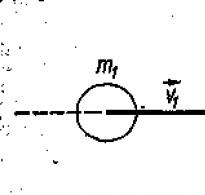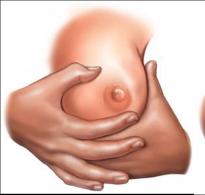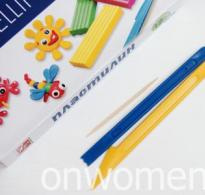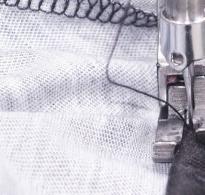How to find the cause of a sewing machine malfunction. How to sew knitwear on a household sewing machine A manual sewing machine does not sew
REASON #1: The machine needle is installed on the wrong side. If you are a beginner seamstress and your troubles with your sewing machine started with changing the needle, let's first take a closer look at how this needle works and why. The machine needle is an absolutely brilliant invention of W. Hunt, and it consists in the fact that there are two grooves along the needle: a long one on one side, and a short one on the other. When this ingenious needle pierces the fabric, the top thread coming from the spool is hidden in a long groove. Thanks to this, the needle and thread passes through the fabric very easily. But the section of the thread that has a short groove on the other side experiences a lot of friction. While the needle goes down, it drags the thread along with it. But during the reverse movement, a section of thread, successfully hidden in a long groove, comes out freely. But the thread in the short groove is unlucky: it has nowhere to hide, and it gets stuck, forming a loop under the fabric, which the shuttle grabs. This is how simple (and at the same time very cunning?) a machine stitch is formed. If you didn’t pay attention or simply couldn’t remember which side to insert the needle into the sewing machine (and looking at the instructions every time, even if you haven’t lost it yet, is so boring!), then now you won’t get confused: the needle needs to be inserted with a long groove in the direction from which the thread is threaded. Failure to follow this rule is a fairly common reason why a sewing machine does not sew: the handwheel spins, the fabric under the presser foot moves, the needle makes frequent strikes, and instead of stitching there is only a uniform row of holes... REASON #2: The new needle is too thin for the thread threaded into the sewing machine. The thread does not fit in the long groove, it protrudes outward, and the holes in the fabric are too large. The thread on the side of the short valley no longer gets stuck in the fabric or does not get stuck every time. You end up with unsightly gaps, or even no stitches at all. Change the needle to a thicker one, or the thread to a thinner one - depending on what is easier for you. REASON #3: The sewing machine won't sew because the top thread breaks every few stitches. See if it gets caught on the threading path: by the spring of the tension regulator, by the thread take-up, by the tip of the needle. Often a coil of thread, having slipped off the spool, gets wrapped around the rod on which it is installed, and this is not immediately noticeable. Modern cardboard reels behave especially poorly. It is advisable to place a smooth plastic circle under them. If it is not included with your sewing machine, cut it out from the bottom of a plastic bottle and make a hole in the middle with a nail heated over a fire.
Sewing machine malfunctions can be detected by external signs. For example, skipped stitches appeared or the upper thread began to loop at the bottom, or the sewing machine began to “knock” while working. Suddenly the fabric began to move poorly or the needle often broke, etc. It is much more difficult to determine the cause of the malfunctions that appear and even more difficult to eliminate them, to repair the sewing machine yourself.
In this video you will learn the reason for the expensive repair of a sewing machine caused by a broken toothed drive belt. You will also learn recommendations on how to avoid this sewing machine breakdown.
To make it easier for you to find a breakdown, we offer a brief overview of the main faults and the reasons for their occurrence, as well as a selection of site articles devoted to these issues. But, before you figure out why a sewing machine or overlocker does not sew or sews poorly, you need to make sure that this model of sewing machine is operated in accordance with its technical characteristics, including eliminating the use of materials, fabrics, threads, needles not specified in the passport or manufacturer's instructions. Let’s also agree that the threading is done correctly and other basic requirements are met, for example, the seamstress does not pull the fabric towards herself with her hand, etc.
1. Sewing machine malfunctions can be grouped into three groups

All emerging malfunctions and malfunctions in the operation of sewing machines can be divided into three main groups: violations of stitch formation; poor quality stitching; malfunctions in the operation of components and mechanisms.
Disturbances in the stitch formation process: skip stitches; stitch length instability; top thread breakage; broken bottom thread, etc.
Poor quality stitching: stitch landing; tightening the material in the line; "oblique" line; poor-quality trimming of fabric edges (overlock); poor-quality tightening of threads into a stitch (looping), etc.
Malfunction of machine devices and mechanisms: "heavy" movement of the machine; increased noise during operation; "jamming"; damage to the needle and other parts.
According to these three groups, we will consider possible malfunctions, from the point of view of the reasons for their occurrence, and, accordingly, ways to eliminate them. You can read the entire article, this information will not be superfluous for you. Or you can immediately find the group of reasons you need with detailed recommendations. At the end of each section there is a list of articles, to one degree or another, devoted to these malfunctions. It is important to understand that finding the causes of sewing machine malfunctions is intuitive. Various kinds of recommendations can only be used as a guide to the direction of the search. An experienced master does not use a “smart” book, he relies only on practice.
2. Reasons for violations of stitch formation in a line

Skipped stitches. The most common reason for stitch skipping in any sewing machine is the lack of a “confident” grip of the needle thread loop by the nose of the hook or loopers. Adjusting this parameter of a sewing machine always requires experience, especially with overlockers. The formation of a loop near the eye of the needle occurs when the needle is raised from the lower position by approximately 1.8 - 2.3 mm. The nose of the shuttle or looper should at this moment pass just above the eye of the needle and almost close to the needle blade. Since it is not always possible to perform high-quality settings for these parameters yourself, we only recommend checking them. This will allow you to determine that the cause of the skipped stitches may be due to another problem.
The occurrence of a skip may be influenced by the compensation spring.
Blunt nose of the shuttle.
When the thread number does not match the needle eye size (thread is too thick).
Large (broken) needle plate hole.
For thin fabric, a needle that is too thick is used.
The needle in the needle bar is loose.
The needle is not installed correctly.
The appearance of excessive play in the components and mechanisms of the machine.
Defective needle.
Broken upper and lower thread. The most common causes of thread breakage can be: thread abrasion; cutting thread with sharp edges of parts; thread rupture due to pinching, overlapping, etc. To detect places where the thread breaks, you need to inspect the entire route of the thread (you can use a magnifying glass). Probable causes of thread abrasion may be: the roughness of the thread guides and surfaces in contact with the thread in the area where it breaks; too much thread tension; decrease in the strength of the thread due to its unwinding. See also:
Reasons for skipping stitches on a sewing machine
Sewing stitch - thread breakage
Industrial sewing machine 1022 class
Sewing machine problems
Do-it-yourself repair and adjustment of overlockers
How does a sewing shuttle work?

Tight stitch. The stitching is pulled together most often due to excessive tension on the top thread and too little pressure of the presser foot on the fabric. First adjust the tension of the lower thread, then set the correct tension of the upper thread. The interweaving of the top and bottom threads of the stitch should be inside the fabric. Adjust the presser foot pressure so that when the presser foot is lowered and the teeth of the feed are raised (the needle is above the presser foot), the fabric can only be pulled out with noticeable force. A rough surface of the presser foot (worn out) can also cause the fabric to pull together in the stitching. The stitching will tighten if the worn teeth of the rack do not advance the fabric well. Therefore, it is not recommended to set the sewing machine in motion with the presser foot down and without fabric.
Fabric tightening. May occur when the fabric motor and needle malfunction. It is difficult to adjust such a breakdown on your own, but you can check it. The teeth of the rack should completely lower ("hide") at the moment when the needle almost approaches the needle plate (1.5 -2.0 mm).
Poor quality cutting of fabric with overlocker. Dull overlock knives do not cut fabric well, which leads to gaps and permanent stitch tightening. A characteristic dull knock when the overlocker is operating indicates that the knives and needle have become dull.
Poor quality stitching. The so-called “loop”, as well as oblique stitching, is formed due to excess top thread. As a rule, the reason for this is the appearance of roughness along the path of the upper thread or a violation of the shuttle stroke settings (Chaika sewing machine). See also:
Why does the line loop?
Sewing machine feet
Sewing threads, which ones are better?
How to thread a sewing machine
Sewing machine Seagull
Setting up a sewing machine. Reika - fabric advancement
Overlock 51 class
4. Malfunction of the components and mechanisms of the sewing machine

Heavy running of the sewing machine. Most often this is caused by a lack of lubrication, clogging of the shuttle mechanism with tow, thread trimmings. Often, heavy running of the machine may occur after replacing the electric drive belt. A belt that is too tight makes it difficult for the sewing machine to rotate easily and causes parts to make noise during operation. Excessive tightening of fasteners and connections of machine parts also makes it difficult for them to rotate.
The sewing machine jams. Sewing machine jamming can occur after long-term storage of the machine. If the machine has not been used for a long time, it is recommended to lubricate it first, and then operate the sewing machine without thread for several minutes. Using the wrong oil will also cause the sewing machine mechanisms to jam. Some types of oils can dry out over time, especially at high temperatures. They turn from oil into glue, which most often becomes noticeable after a long period of “downtime”. Rarely, parts can break down, leading to malfunction of the machine.
Needle breakage. Needle breakage usually occurs due to inept seamstress work. The fabric should not be pulled towards you by hand. Correctly adjust the presser foot pressure on the fabric and the lifting height of the dog teeth, and you will no longer need to “help” the machine with your hand. When sewing coarse fabrics, a needle that is too thin is used. A needle is used that is not intended for this model of sewing machine. The needle is not inserted into the needle bar all the way. The needle is not centered on the plate's needle hole. See also:
Reasons for a broken needle on a sewing machine
Sewing machine lubrication
Electric sewing machine drive
Flywheel - Singer
How does a sewing pedal work?
How to replace an electric drive
This article contains all the typical and simple faults and repair methods for a sewing machine.
How does a modern household electric sewing machine work? Basic malfunctions of components and mechanisms.
This article contains expert advice on how to independently disassemble a modern household sewing machine from Brother, Janome, etc.
Such a “trifle” as winding thread on a bobbin often creates a lot of inconvenience when sewing. For some reason, it is not always possible to do this quickly and “without problems.” Let's figure out why it is sometimes difficult to wind thread onto a bobbin and what needs to be done to fix minor damage to the winder.
It's rare, but sometimes you can find foot-operated machines. The best solution, instead of repairing the foot drive, is to install an electric drive on the machine. This is not difficult to do and anyone with a screwdriver can install it with their own hands. But, if you still need recommendations on how to repair or adjust the foot drive, this article is at your service.
The main malfunctions and malfunctions of these sewing machines, as a rule, are not related to its adjustment. Sometimes it is enough to install the needle correctly, replace low-quality threads, select the correct tension of the lower and upper threads, and the machine will work perfectly again.
If the foot drive is, one might say, a complete antique, then the manual drive can be used, especially for beginners learning to sew. Read this article to learn how to repair this device yourself.
Sewing machine faults and problems It will be easier to fix if you understand how the sewing machine works and which part is used for what. Study carefully the structure of your machine according to the instructions or using our article.
Why did a modern household sewing machine suddenly start skipping stitches? The sewing machine repairman explains.
A household sewing machine is an indispensable assistant for a housewife. This little assistant can handle anything. Hemming trousers or a skirt, hemming the edges of curtains and even embroidering - all this is possible for a housewife if she knows how to use a sewing machine. But, unlike other household appliances, a sewing machine is a very capricious unit, sometimes it simply ends up sewing. In order for the device to be a reliable assistant for you, it is useful to know why a sewing machine does not sew. In this article we will analyze all the main malfunctions of such devices and give tips on how to eliminate them.
Main malfunctions of sewing machines:
- The presser foot mechanism does not feed material or feeds it poorly;
- thread break;
- the needle breaks;
- the fabric does not move;
- shuttle malfunction;
- The drive belt is loose.
The machine does not feed fabric well
This kind of malfunction occurs very often. When the machine operates correctly, the fabric should move without jerking, evenly, at the same speed. If this is not the case, then most likely the fabric feed mechanism is faulty. It happens that the cause of such a breakdown is the fault of the housewife herself, who, to speed up sewing, pulls out the fabric, helping the machine with her hands. As a result, the feed conveyor may malfunction. In addition, pulling the fabric with force can bend or even break the needle.

If the fabric feed mechanism is faulty, you will need to adjust it. The feed dog of the feed mechanism does not fit tightly enough to the presser foot, causing the fabric to slip. Adjusting the rack is quite a troublesome task, and in this case it is better to contact a professional adjuster. It happens that after prolonged use, the teeth of the feed rack become dull. To avoid this, do not allow the sewing machine to run idle without fabric.
Broken thread
There are a number of reasons why a sewing machine does not sew a stitch and breaks the thread. One of them is incorrect adjustment of the upper thread tension. The thread is simply overtightened and breaks when fed, not having time to follow the needle. To achieve proper operation, you must first completely loosen the upper thread regulator, and then, gradually increasing the tension, ensure that the machine operates correctly so that the thread does not break.

Another reason is a crooked needle. During operation, it may bend and touch the needle plate or the presser foot that presses the fabric. As a result, the thread catches on the edges and breaks. The Seagull sewing machine is especially susceptible to this. Let’s look at why other machines don’t sew further.
Often the thread can break, oddly enough, due to its quality. Threads for sewing machines and for hand sewing or embroidery are noticeably different. For hand sewing - cotton, they have an uneven structure and feel velvety when used. If you put such threads in a sewing machine, they will quickly become frayed and tear. It is important to choose high-quality threads for sewing machines. They are thin and elastic.
The needle breaks
This is also a serious malfunction, due to which the sewing machine does not sew. Why does the needle break? There may also be several reasons. The first of them is the incorrect installation of the needle itself in the needle bar. If it is not inserted all the way, then during operation it may hit the shuttle and will inevitably break. The needle position must be constantly checked. If its fastening in the needle bar is loose, then you need to tighten it, after inserting the needle up until it stops.
Often needle breakage occurs due to incorrect selection. If, after sewing thin fabrics, you decide to sew denim fabrics with the same needle, this will inevitably lead to breakage. The needle must be selected according to the thickness and type of fabric. For coarser fabrics, there are special needles that differ in thickness and sharpening. There are also universal needles suitable for all types of fabrics. In addition, needles can break due to poor quality material from which they are made. Don't buy cheap needles from unknown sellers and you can avoid wasting money.
The shuttle is faulty or its adjustment is incorrect
Why doesn't the Podolsk hand sewing machine sew? Most likely, this is due to the operation of the shuttle. The quality of these machines often depends on its condition. What malfunctions can there be? Dirt or moisture may get into the shuttle, then it may be difficult to rotate, and in some cases even jam. Because of this, a manual sewing machine does not sew. Why is this happening?

Long downtime of the machine
If you have not used the sewing machine for a long time, moisture may get into the hook, which will inevitably lead to corrosion. To avoid this, you need to periodically lubricate the machine, even if it has been idle for a long time. How to do this correctly is written in the instructions for your sewing machine.
It's another matter if dirt gets into the shuttle. This can happen, on the contrary, from long-term and continuous use of the machine. The threads you sew with are not perfectly clean; there may be dirt or dust accumulated on them. Together with the lubricant, all this forms a viscous mass, which clogs the shuttle. To avoid this, periodically the shuttle must be disassembled and cleaned, adding new lubricant.
Drive belt loose
Another reason why a sewing machine does not sew may be a loose drive belt. This can be noticed immediately after you turn on the machine and press the drive pedal. The motor may spin idle, but the machine will not sew. This can be easily fixed without calling a technician. You need to loosen a couple of bolts on the engine mount and move it down a little, checking the belt tension with your hand. Once it is tight, secure the engine in this position. Just remember to turn off the power to the machine before this operation.

If you have an old foot-operated machine, the above action will not work. These devices do not have a belt tensioner. In this case, the belt must be removed and shortened by approximately one centimeter. Then fasten it with a bracket and install it back. You need to remember that you can’t overtighten the belt either. This can cause the machine to run rough and lead to pulley failure.
This article provided basic answers to the question of why the sewing machine does not sew. Most breakdowns can be fixed on your own. But for things like fine tuning, it’s best to contact a technician or service center. There is no need to save where you can lose more.
When a machine stitch breaks in a visible place, it not only spoils the appearance of the product and forces you to re-stitch the seam, but also tires you with the need for constant rework if the problem recurs. This defect occurs when the sewing machine does not pick up the bobbin thread.
The cause of grip failure can be inconsistencies between threads and needles in relation to the density of the fabric, a violation in the adjustment of the devices that tension the thread and hold the needle, and design faults of sewing equipment.
General information about the problem
To create a stitch on the surface of the fabric when sewing, the needle with the top thread is lowered to the shuttle. The nose of the shuttle device comes close to the needle, hooks the loop and draws the thread around itself. When the shuttle is turned, a loop placed on the spout catches the bottom thread, and the stitch is completed from the wrong side of the fabric. In order for the hook nose to form a loop, the gap between it and the needle blade should not exceed 0.3 mm.

If the interaction between the shuttle nose and the needle point is disrupted due to improper clearance, the thread will not be picked up and a skipped stitch will result. The reason for the increase in the gap is an attempt to sew fabrics that are too dense (sew the hem of jeans folded in several layers). A household machine is not designed for such overloads.
In modern models of sewing devices, such as Brother, Janome or Juki hzl g 220, the shuttle is connected to the upper and lower shaft using a belt with teeth. The shafts also have teeth, the belt clings to them and drives the electric drive. When overloaded, the teeth do not adhere well, the settings of the sewing device are lost, and a gap appears between the needle and the shuttle nose.
Poor grip of the lower thread can be associated not only with overloads of the electric drive. More common causes are needle calibration violations or small defects in the shuttle device that arose during operation.
Causes of malfunction
Reasons caused by the design features of the machine. Problems with picking up thread and quality stitching may be associated with a malfunction of the shuttle mechanism or the occurrence of defects in it:
- blunting of the shuttle nose;
- shuttle settings failure;
- violation of the spatial orientation of the shuttle device;
- burr on bobbin case;
- poor needle bar calibration;
- The needle bar is set too high or too low.
- misalignment of the screw on which the bobbin is secured;
- violation of synchronism in the movements of the lower compartment and the needle bar.
Some of the listed shortcomings can be easily eliminated by adjusting the machine settings. It is better to invite a specialist to correct the position of the shuttle.
Malfunctions related to the needle and needle holder. The lower thread is not picked up if problems arise due to the needle:
- the needle does not match the density of the fabric being sewn - too thin or thick;
- the needle bulb does not correspond to the needle holder - this happens if an industrial needle is selected for a household machine or a needle with a smaller bulb diameter than necessary;
- needle bent or blunt;
- the thread chosen is thicker than the needle - in this case, the thread clings to the eye and inhibits the formation of a loop in the shuttle device.

The fabric moves unevenly. If the hole in the needle plate is badly broken, then the fabric is pulled into it along with the needle when sewing. Its uneven progress prevents the thread from passing freely into the eyelet. The threads are not picked up, the loop is not formed, and stitch skipping occurs.
The reason for the uneven movement of the fabric is a failure in the settings of the rack teeth. When the needle goes down or up, the needle moves at the same time, pushing the fabric along with its teeth. If their interaction is poorly regulated, the fabric gathers, the lower thread is not picked up, and the upper thread breaks.
What else could be the reason? Stitches may be caused by threads. It happens that during the sewing process the lower thread breaks and simply winds around the bobbin, spinning idle. That is why it is not picked up by the nose of the shuttle, and looping from the wrong side of the material stops.
Thread breaks and skipped stitches also occur if the bottom thread is thicker than the top thread. In this situation, it is difficult to grab, and the seam is defective. To obtain a high-quality stitch and smooth operation of the sewing device, it is necessary that the lower thread be slightly thinner than the upper and elastic.
The use of twisted top threads provokes seam defects, since this type of thread forms either small or large loops, and they cannot be captured by the shuttle nose.
Troubleshooting Methods
If the machine does not want to catch the lower thread due to imbalance, it is necessary to restore the balance by adjusting the distance between the needle and the hook nose. To do this, set the straight stitch mode, remove the needle plate, and lower the needle to its lowest position. Then it is raised, making sure that the nose passes 1-2 mm above the eye of the needle, and 0.15-0.20 mm remains between the needle blade and the nose. The required clearance is adjusted using a screw near the shuttle.

For sewing machines of older brands such as “PMZ”, “Podolsk 142” and “Chaika” models, the settings are made in the zigzag stitch mode. The parameters are the same as for modern machines. But the guideline for them is the distance between the nose of the shuttle and the eye of the needle at the moment of left and right punctures of the tissue with a needle.
To troubleshoot the problem, there are several general rules that will help you deal with the situation, regardless of the make of the car. What needs to be checked and corrected is shown in the table below.
| Problem | Elimination |
| The thread tucked into the bobbin is too loose or too tight - check by hand or by trial stitching | Check that the bobbin is threaded correctly. Adjust the tension using a screw next to or inside the hook |
| Shifting the needle bar to the side when sewing | Adjust the tension for the upper thread |
| Heavy shuttle movement, skipped stitches, broken thread grip | Clean out the lint and fuzz that has accumulated in the shuttle and interferes with the movement of the mechanism. |
| During stitching, the fabric is pulled under the panel, disrupting the operation of the shuttle device | Replace the needle. If it is bent or blunt, the machine may pull material into the hook. |
| The thread is wound around the stitch, loosely tightened | Repair the shuttle. Thread grip may be impaired due to nicks, cracks, or rust. |
Preparation for work and other important points to prevent problems
One of the simplest steps to help eliminate thread snagging problems is to properly prepare your sewing device for use. To do this you need:
- Check that the machine is level and stable.
- Insert the desired needle into the needle holder, secure it with a screw and check the reliability of the fastener.
- Place the spool or bobbin of thread on the riser and pass the upper thread through all holders and guides in accordance with the diagram supplied with the sewing device.
- Thread the thread into the eye of the needle and pull the end back 10-15 cm.
- Place the bobbin with the lower thread in the shuttle and bring the end of the thread out, next to the end of the upper thread.
- Connect the device to the network.
- Make a test stitch on a spare scrap piece.
If the machine is properly prepared for operation, the risk of the lower thread being picked up incorrectly and breaking is significantly reduced.

To prevent problems with the hook catching the loop, you must carefully select the threads. They should be smooth, elastic and not curled. Their thickness is chosen in strict accordance with the needle number and fabric density.
It happens that all efforts to manually adjust the machine did not give the desired result. In this situation, you need to invite a specialist who will diagnose and find out the cause of the problem, eliminate it using special tools and prevent more significant malfunctions.
What to do if the sewing machine does not pick up the bobbin thread, see the video below:






